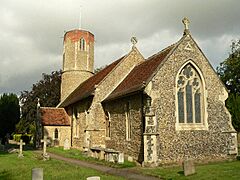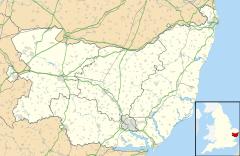Hasketon facts for kids
Quick facts for kids Hasketon |
|
|---|---|
 St Andrew’s Church, Hasketon |
|
| Area | 6.81 km2 (2.63 sq mi) |
| Population | 402 (2011) |
| • Density | 59/km2 (150/sq mi) |
| OS grid reference | TM248506 |
| District |
|
| Shire county | |
| Region | |
| Country | England |
| Sovereign state | United Kingdom |
| Post town | Woodbridge |
| Postcode district | IP13 |
| Dialling code | 01473 |
| Police | Suffolk |
| Fire | Suffolk |
| Ambulance | East of England |
| EU Parliament | East of England |
| UK Parliament |
|
Hasketon is a small village and civil parish located in the East Suffolk District of Suffolk, England. It is home to St Andrew's Church, which is special because it has a round tower. This makes it one of only 38 such churches in Suffolk! The church stands in a peaceful, tree-lined churchyard.
Contents
History of St Andrew's Church
People have worshipped at St Andrew's Church for over 900 years. This old church shows building styles from many different time periods. We can learn about its history from what we see and from old records.
Early Beginnings: 11th Century
The oldest part of the church is the nave, which is the main part where people sit. Builders used special masonry (stone work) that shows it was built around the late Saxon or early Norman times. This means it was built just before or after the Norman Conquest in 1066. You can even spot a tiny, now-blocked window from this very early period.
Adding the Round Tower: 11th to 12th Century
A little later, probably in the late 11th or early 12th century, the unique round tower was added. It stands at the west end of the nave.
Changes Over Time: 13th to 15th Century
In the 13th century, single, tall, narrow windows called lancet windows were put in the north walls of the nave and chancel (the area around the altar).
Around 1300, the round tower was made taller. An octagonal (eight-sided) belfry was added to the top. This part was later fixed using brick. New windows were also added to the tower, nave, and chancel around this time.
During the 14th and early 15th centuries, more windows were added to the nave and chancel. These likely replaced older ones. The north and south doorways of the church also date from the 14th century.
The Reformation and Later Changes
During the English Reformation, the inside of the church changed a lot. This was to fit the new ways of worship. Many colourful carvings, stained glass, and the rood screen (a screen separating the nave from the chancel) were removed.
In 1844, a new rector (the church's leader), Thomas Maude, arrived. He started a big project to restore the church step by step. The font (a basin for baptisms), which was first given around 1450, was cleaned. A small gallery at the west end of the nave was replaced with a carved wooden screen for the tower.
The biggest restoration work happened in the 1860s. In 1863, the nave was worked on, and the church got a new roof. The chancel was restored, and a vestry (a room for clergy) was added in 1865. New benches were put in the nave in 1866, and the porch (the entrance) was rebuilt two years later. In 1899, a new bell was added, and three others were remade.
The church received its current organ in 1904, the same year the choir-stalls (seats for the choir) were made. The reredos (a decorated screen behind the altar) was put up in 1920.
In more recent years, the church has seen new interior decorations, kneelers (cushions for kneeling), and a list of its rectors. Today, the building is still used regularly for Christian worship.
Notable Burials
Peggy Harrison (1907-1993) is buried in the churchyard. She was the wife of Sir James Harwood Harrison, a well-known Conservative Party politician. He is buried in Bugbrooke, Northamptonshire, where his family lived.



